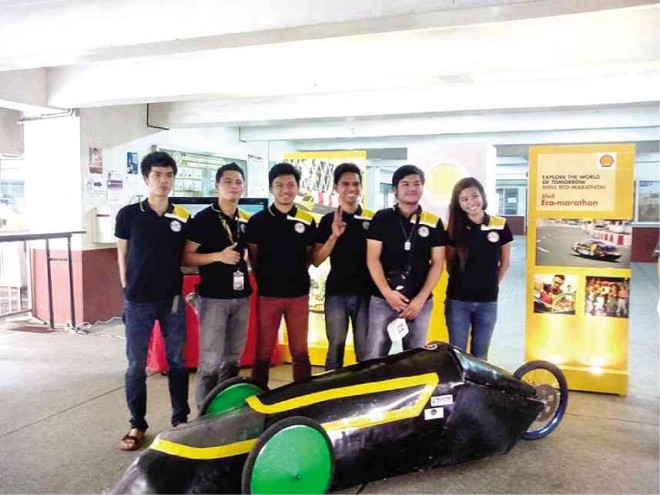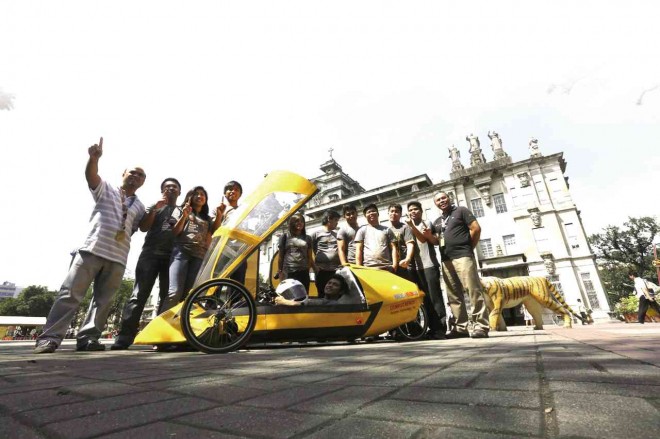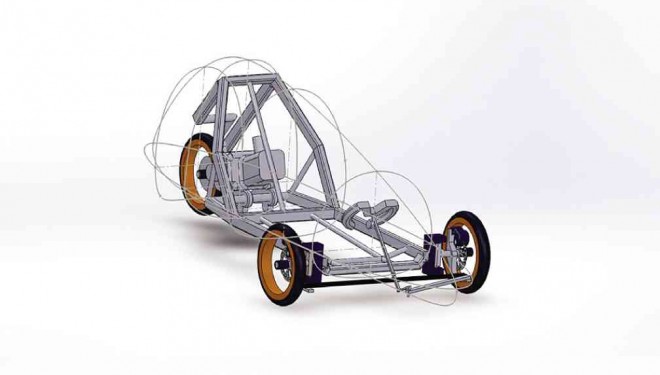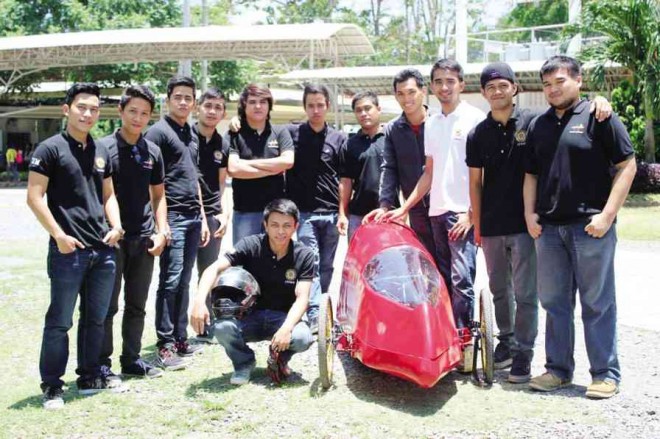Eco-marathon to showcase students’ ‘green’ car ideas
For Shell Eco-marathon Asia 2015 on Feb. 25 to March 1, Filipino participants are building cars that can go much farther—on less fuel.
The University of Santo Tomas (UST) Eco Tigers will show up at Quirino Grandstand, the competition venue, with “Tiger 400,” 13 kilograms lighter than last year’s model, which finished fifth in the prototype petrol gasoline contest.
Eco-marathon entries are either prototype or urban concept motor vehicles. Prototype cars are built for better aerodynamics and fuel efficiency, while urban concept models follow roadworthiness standards, such as four wheels and a brake pedal.
Each category will have six winners based on energy type—electric battery, hydrogen, petrol gasoline, alternative gasoline, diesel and alternative diesel. The units should run an average of 25 kilometers per hour.
“If you compare [the units] to [ordinary] cars, the comfort goes,” said Elli John de Arroz, a fourth-year mechanical engineering student who will drive the Tiger 400. “They’re narrow. There’s no tint or aircon, no ventilation.”
Article continues after this advertisementEco Tigers replaced this year the fiber-glass casing with the lighter aluminum and moved from an electric gasoline to a gasoline engine, De Arroz said.
Article continues after this advertisementNow weighing 65-70 kg, the unit is still a work in progress, team manager Kevin Rivera said. “We’re still trying to make improvements … It’s an ongoing project to get better results … We improve via solid work and test runs.”
UST also has an entry in the urban concept category.
The school is up against some 176 teams from 20 countries, including first-timers South Africa, Saudi Arabia, Oman, Australia and Bangladesh.
The Tiger 400 leads 34 vehicles from 25 schools from the Philippines, second to Indonesia’s 35. The number is higher than the 15 from nine schools last year, when the Philippines first hosted the marathon.
“It’s going to be a very good spread,” said Roberto Kanapi, Shell Philippines’ vice president for communications. “It’s beautiful because these are students. They can use whatever they have in their head, in their mind, to build cars and make them very efficient.”
Car named Eve
Polytechnic University of the Philippines (PUP) will be entering “Eve,” said Maria Linnea Dimaano, a mechanical engineering student who manages Team PUP Hygears.
The team of seven will compete in the prototype diesel event. Another group, Team PUP Manila, will face UST.

TEAM PUP Hygears presents its entry to Shell Eco-marathon 2015 on Dec. 10. PHOTO COURTESY OF TEAM PUP Hygears
Eve, short for economic vehicle, has a chassis made of stainless steel and its body is fiber glass. The car, weighing about 100 kg, does not claim any technological breakthroughs. But the team is not dismissing a good showing in the Eco-marathon, Dimaano said.
“Our goal is to break our previous record,” said Eco Tigers team leader Paolo Jose, adding that the competition was far ahead.
In the prototype petrol gasoline division, their 172.3-kilometer-per-liter (kpl) car followed Universitas Indonesia’s
464.5 kpl. The topnotcher, from Thailand, obtained 1,796 kpl.
Last year, the most efficient car, entered by Team How Much Ethanol of Thailand, logged 2,730.8 kpl. The No. 2 team, also Thai, holds the Asian record, registering 2,903 kpl in 2012. The global record is nearly 3,800 kpl.
The University of Mindanao’s (UM) Team UMyong, an all-male group of 12 mechanical engineering students, was setting modest goals for its debut in the competition, team manager Francis Justine Sombillo told the Inquirer.
“We do not aim for the top spot. Mindanao is far [from the national center] so there’s a technology gap and limited resources,” Sombillo said, explaining that their P80,000 unit has a scooter engine, and the chassis and aluminum case were bought using donations.
PUP Hygears faced the same problem, Dimaano said. The team name combined “hybrid” and “gears” because their initial plan was to compete as a diesel hybrid, “but due to lack of resources, we competed as a diesel prototype.”
To limit the cost to P15,000, they recycled parts of last year’s unit and made the case themselves. They also sold candy on campus to raise more money.
“We learned to create ways for everything,” Dimaano told the Inquirer. “We do not have enough funds? We sell candy. We have no money to buy a needed part? We produce it from scrap.”
Meanwhile, Team UMyong’s Ferrari-red unit, “Lumad,” is practically a collation of four undergraduate theses tackling the engine, body, chassis and auxiliary parts.
They are still seeking donations for accommodations in Manila but are determined to make it, Sombillo said. “What we aim, through our vehicle, is to symbolize UM and Mindanao, what we have and what we can boast.”
‘Indigenous’ car
Their entry’s name fits, as Lumad refers to indigenous groups in Mindanao, including those in Davao City, where UM is based.
UMyong also wants to see their eco-car “applied to society,” Sombillo said. They want it to spark interest in solving the energy problem in the south.
De Arroz expressed the view that it would soon be normal to see cars with eco-friendly features outside the Quirino Grandstand track and on the road.
“It’s possible,” he said. “The speed [of the units] can equal that of ordinary cars … Things will slowly improve. We can observe that now. The cars we see today are less and less hazardous to the environment.”
“The message here is that fossil fuels will not last forever,” Kanapi said. “There’s a need for us to conserve, to have efficient vehicles. This is what we call sustainable mobility.”
“The [goal] is to get that information to the students at a very early stage. They [need to] learn and practice sustainable mobility,” he added. “[With the Eco-marathon,] things like driving habits come into play … They also exchange knowledge on eco-cars.”
Dimaano agreed. “The Shell Eco-marathon not only challenges the student to create a fuel-efficient car, it promotes the value and the availability of different energies … and how we can maximize usage for a greener tomorrow.”


